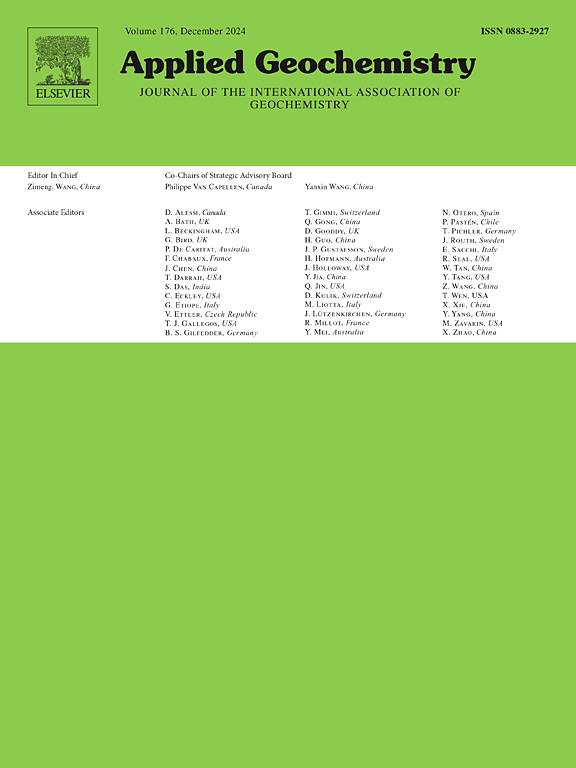Properties of solid bitumen formed during hydrous, anhydrous, and brine pyrolysis of oil shale: Implications for solid bitumen reflectance in source-rock reservoirs
IF 3.1
3区 地球科学
Q1 GEOCHEMISTRY & GEOPHYSICS
引用次数: 0
Abstract
Solid bitumen reflectance (BRo in %) is widely used as a thermal maturity proxy in source-rock reservoirs, yet solid bitumen texture and physical attributes may be affected by varying environmental constraints during its formation, e.g., water saturation, mineral catalysis, or salinity. Herein we investigated the development of solid bitumen properties during artificial maturation using three diverse (lacustrine to marine) oil shale samples containing abundant amorphous H-rich sedimentary organic matter (bituminite). The oil shales were treated via pyrolysis (320 °C, 72 h) using hydrous, anhydrous, and brine conditions, causing the development of a newly formed solid bitumen in the experiment residues from the thermal conversion of bituminite. The properties of the newly formed solid bitumen then were evaluated via geochemical screening tests, optical and electron microscopy, and infrared spectroscopy. Experimental residues also were treated via solvent extraction, allowing characterization of the effects of extraction on solid bitumen. Results showed that bituminite with higher resin and asphaltene components evolved to a solid bitumen with higher reflectance (as a percentage of the original value) when exposed to the same heat treatment, relative to bituminite with higher saturate and aromatic components. Aromatization of solid bitumen also was generally more pronounced in the presence of deionized water relative to anhydrous conditions, supporting prior observations. These results suggest the compositions of primary sedimentary organic matter, and the local concentration of water, affect the development of solid bitumen during thermal advance, potentially explaining the origin of multiple solid bitumen populations with varying reflectance in source-rock reservoir samples or in a single microscope field. Experiments using brine were inconclusive regarding enhanced/decreased aromatization, which could be attributed to the salinities of the brines used in the tests. Extraction of residues caused a consistent increase in BRo values, suggesting that migrating or expelled oils could cause an increase in BRo via natural solvation and absent an increase in temperature. This work provides insights into the development and evolution of BRo in source-rock reservoirs as a function of the composition of the original bituminite and changing environmental conditions, with potentially broad application for petroleum prospecting and resource estimation.
油页岩含水、无水和盐水热解过程中形成的固体沥青的性质:对源岩储层中固体沥青反射率的影响
固体沥青反射率(BRo in %)被广泛用作源岩储层的热成熟度指标,但在形成过程中,固体沥青的结构和物理属性可能会受到各种环境约束的影响,例如含水饱和度、矿物催化作用或矿化度。本文利用三种不同的(湖相和海相)油页岩样品(含丰富的无定形富h沉积有机质(烟煤))研究了人工成熟过程中固体沥青性质的发展。油页岩分别在有水、无水和卤水条件下进行热解(320℃,72 h)处理,在烟煤热转化的实验残留物中形成了一种新形成的固体沥青。然后通过地球化学筛选、光学、电子显微镜和红外光谱对新形成的固体沥青的性质进行了评价。实验残留物也通过溶剂萃取处理,允许表征萃取对固体沥青的影响。结果表明,在相同的热处理条件下,相对于具有较高饱和组分和芳香组分的沥青,具有较高树脂和沥青质组分的沥青演变为具有较高反射率(占原始值的百分比)的固体沥青。相对于无水条件,在去离子水存在的情况下,固体沥青的芳构化通常更为明显,这支持了先前的观察结果。这些结果表明,原生沉积有机质的组成和水的局部浓度在热推进过程中影响固体沥青的发育,可能解释源岩储层样品或单一显微镜场中不同反射率的多个固体沥青群的起源。使用卤水的实验在增强/减少芳构化方面尚无定论,这可归因于试验中使用的卤水的盐度。残留物的提取导致了BRo值的持续增加,这表明迁移或排出的油可能通过自然溶剂化而不增加温度而导致BRo值的增加。研究结果揭示了烃源岩储层中溴化物的发育演化与原始烟煤组成和环境条件变化的关系,在油气勘探和资源评价中具有广阔的应用前景。
本文章由计算机程序翻译,如有差异,请以英文原文为准。
求助全文
约1分钟内获得全文
求助全文
来源期刊

Applied Geochemistry
地学-地球化学与地球物理
CiteScore
6.10
自引率
8.80%
发文量
272
审稿时长
65 days
期刊介绍:
Applied Geochemistry is an international journal devoted to publication of original research papers, rapid research communications and selected review papers in geochemistry and urban geochemistry which have some practical application to an aspect of human endeavour, such as the preservation of the environment, health, waste disposal and the search for resources. Papers on applications of inorganic, organic and isotope geochemistry and geochemical processes are therefore welcome provided they meet the main criterion. Spatial and temporal monitoring case studies are only of interest to our international readership if they present new ideas of broad application.
Topics covered include: (1) Environmental geochemistry (including natural and anthropogenic aspects, and protection and remediation strategies); (2) Hydrogeochemistry (surface and groundwater); (3) Medical (urban) geochemistry; (4) The search for energy resources (in particular unconventional oil and gas or emerging metal resources); (5) Energy exploitation (in particular geothermal energy and CCS); (6) Upgrading of energy and mineral resources where there is a direct geochemical application; and (7) Waste disposal, including nuclear waste disposal.
 求助内容:
求助内容: 应助结果提醒方式:
应助结果提醒方式:


